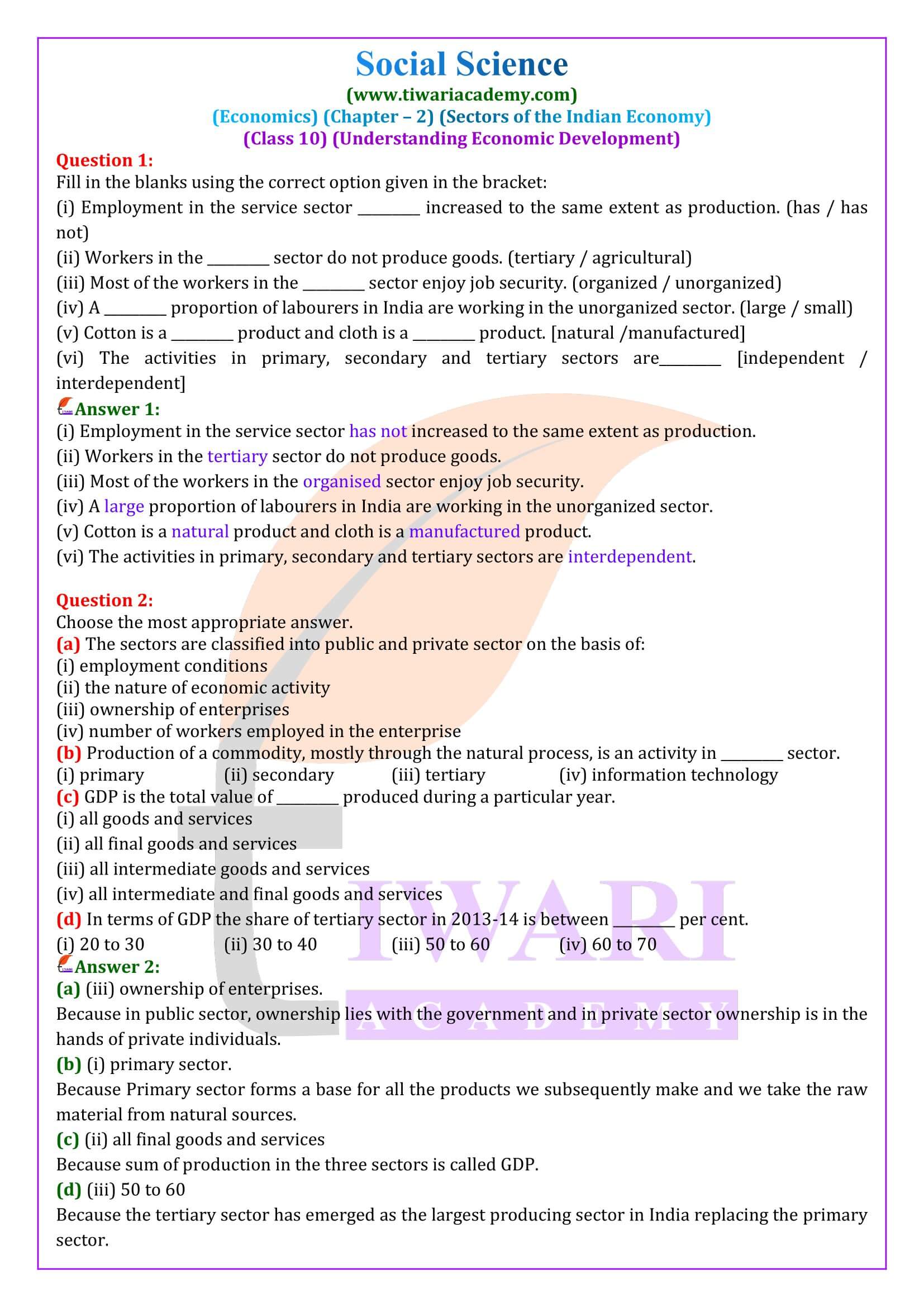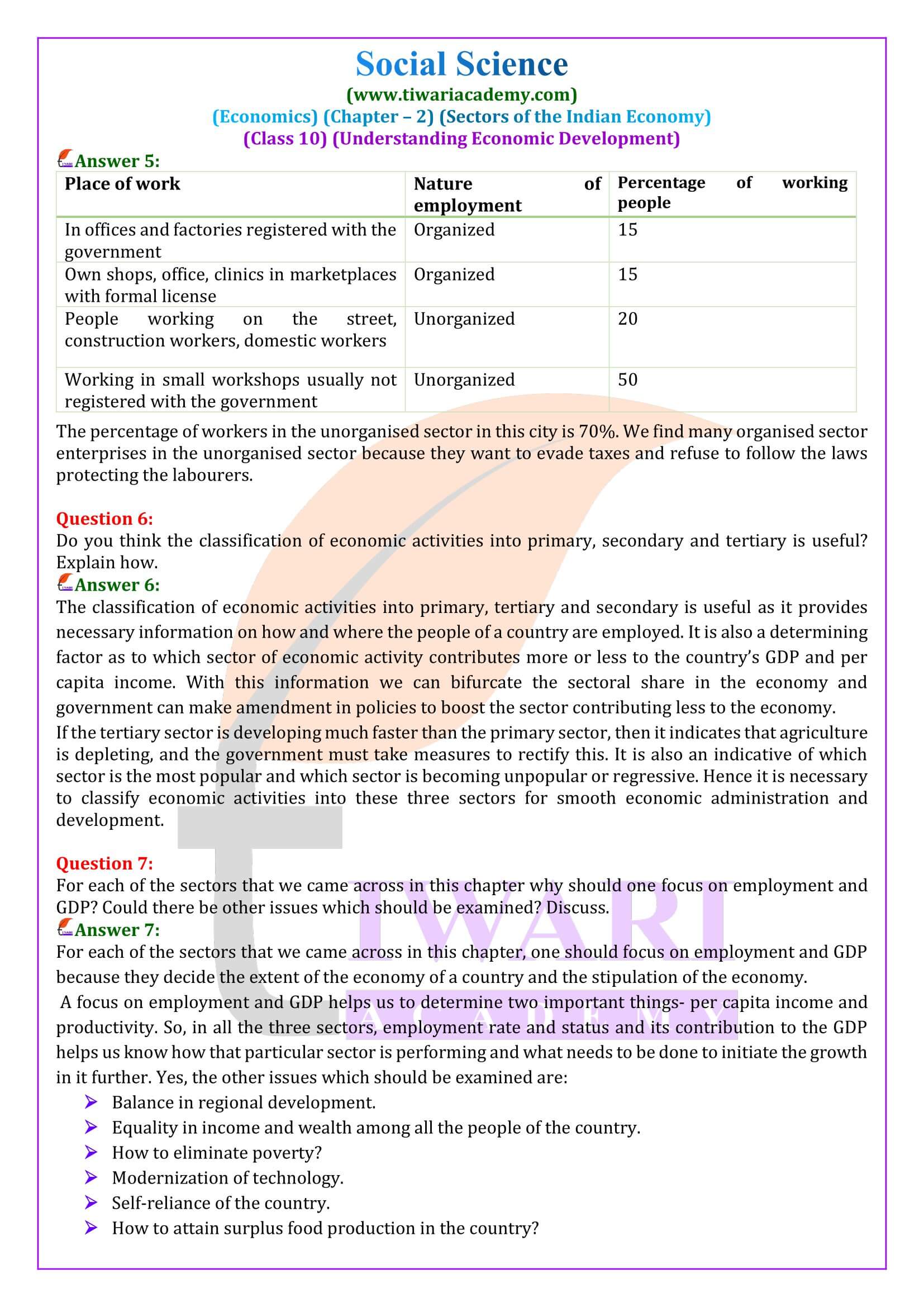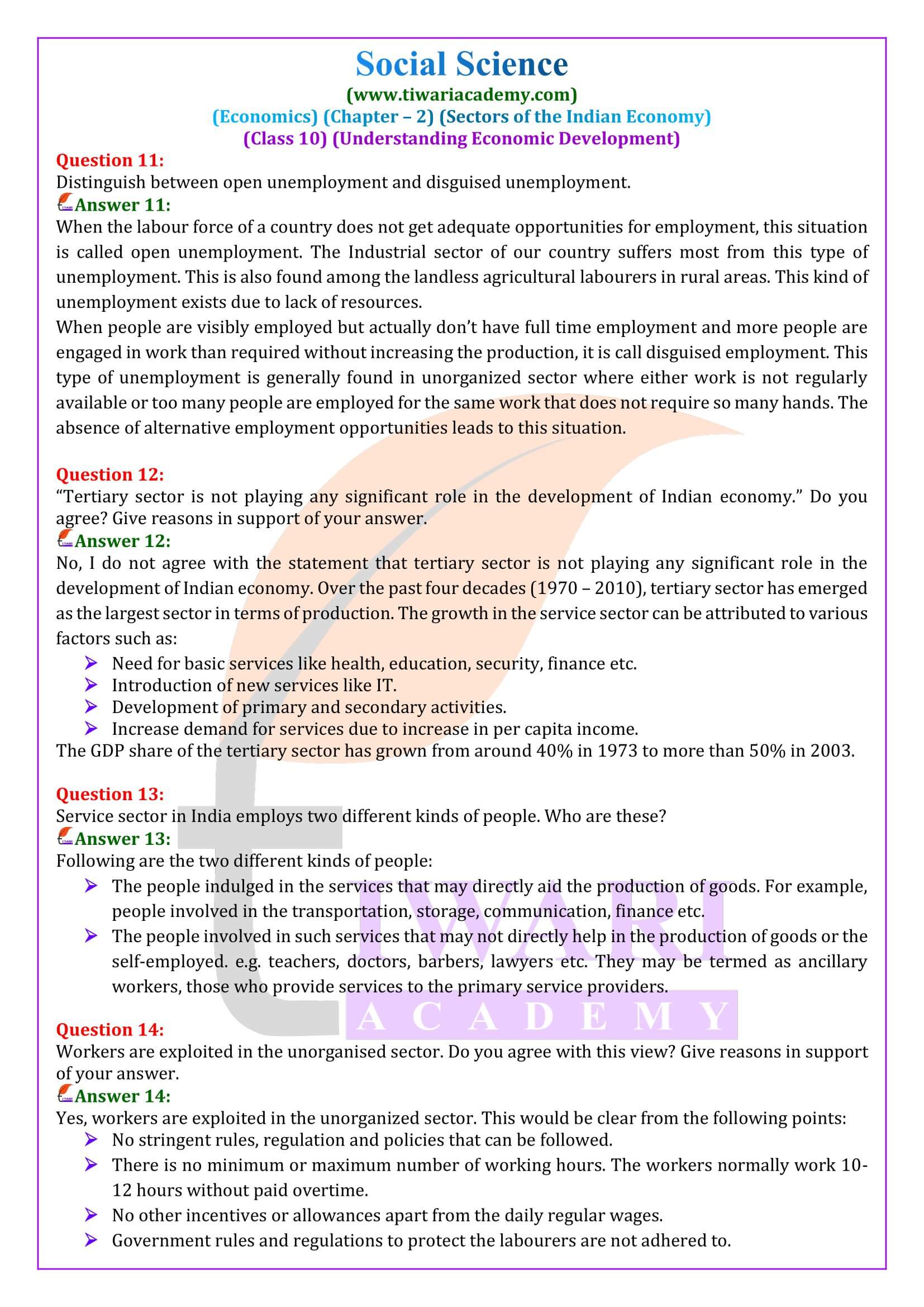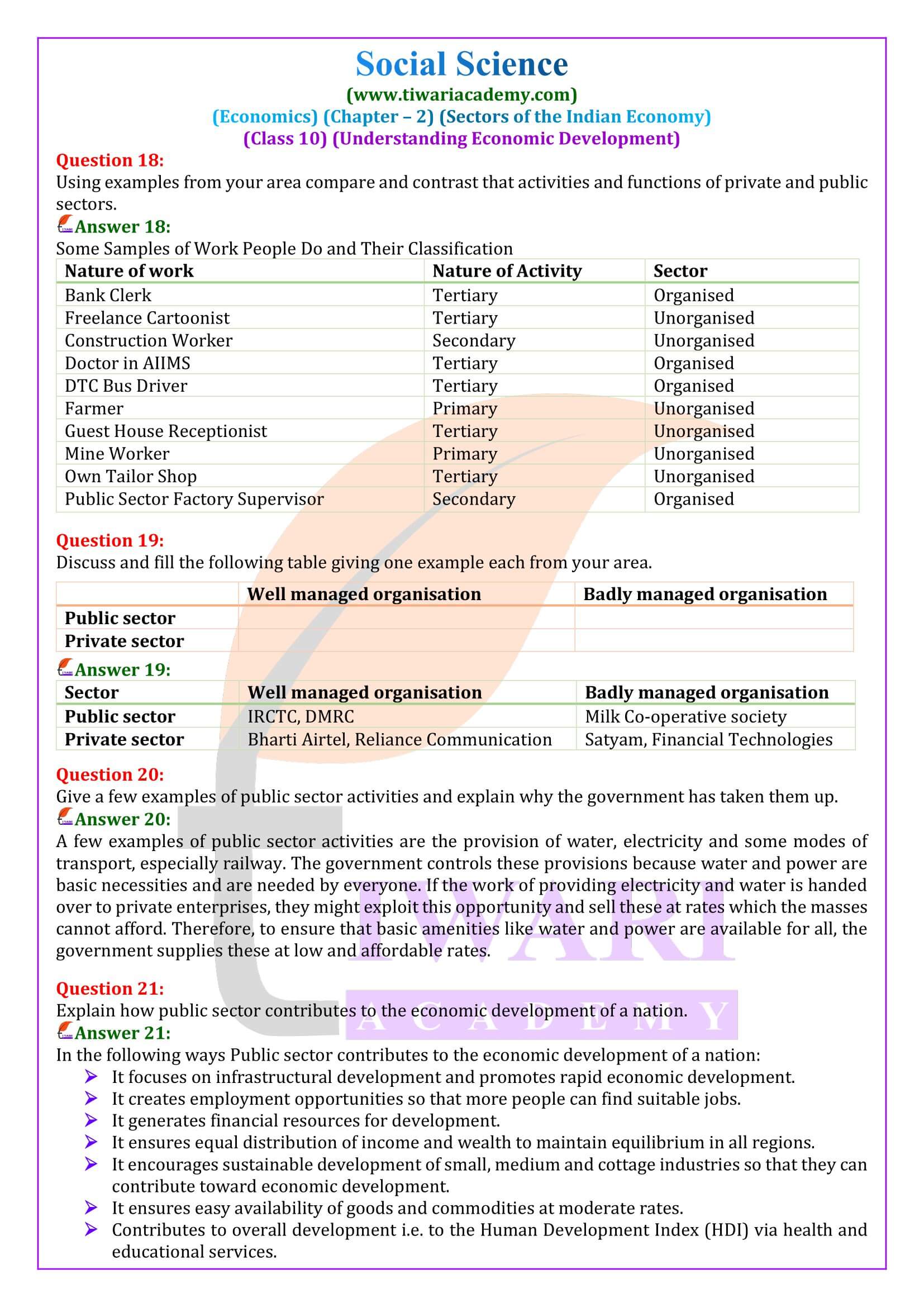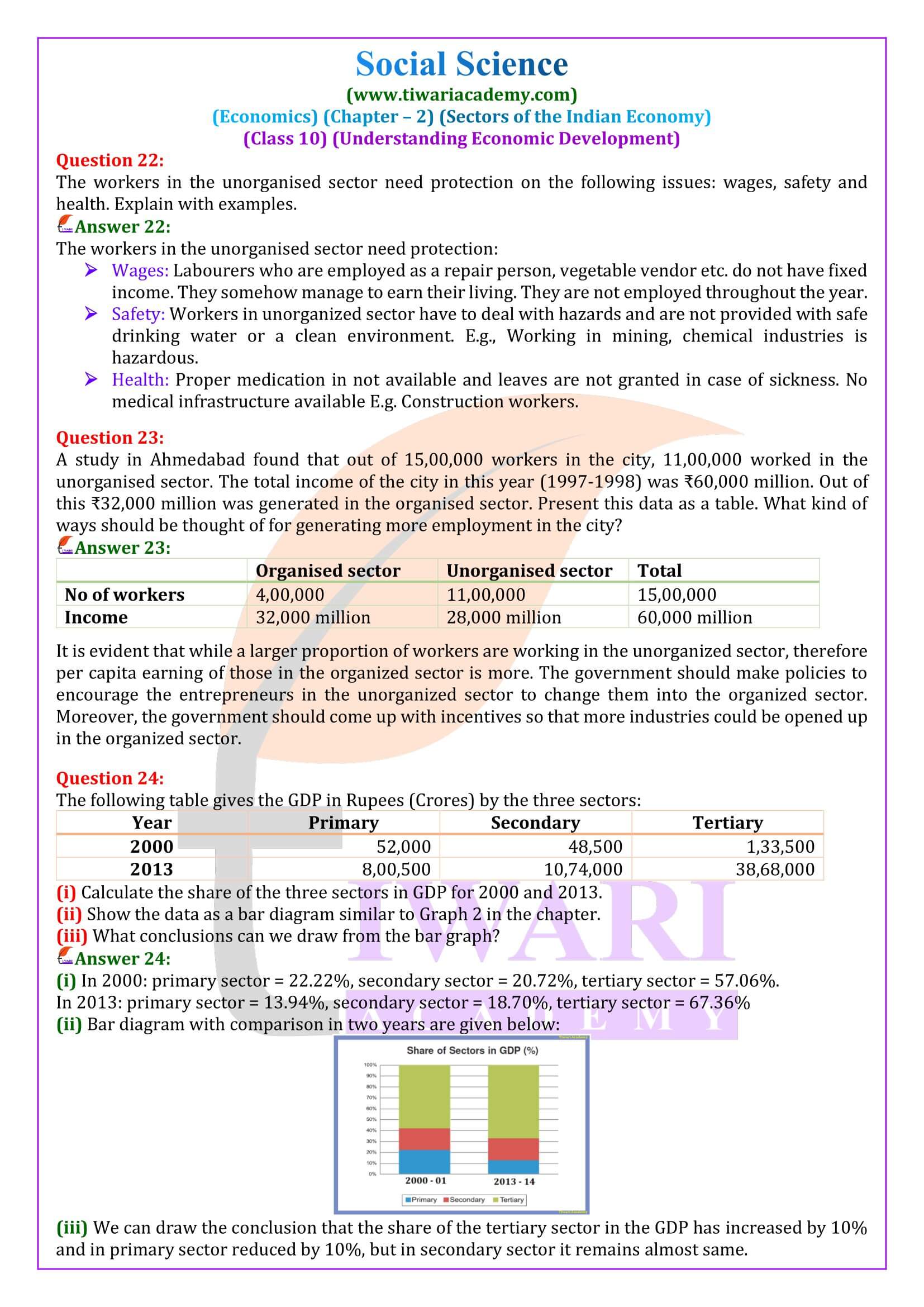NCERT Solutions for Class 10 Economics Chapter 2 Sectors of Indian Economy in Hindi and English Medium updated for new academic session 2025-26 based on new NCERT Books 2025-26 following the latest CBSE Syllabus for new session. Download Offline apps, which works without internet once downloaded. Ask questions and give answers of other questions in Discussion Forum.
NCERT Solutions for Class 10 Economics Chapter 2
| Class: | 10 |
| Subject: | Social Science – Economics |
| Chapter 2: | Sectors of Indian Economy |
| Academic Session: | 2025-26 |
Class 10 Economics Chapter 2 Sectors of Indian Economy
Class 10 Economics Chapter 2 Sectors of Indian Economy in PDF form to free download is given below updated for new academic session 2025-26. Download NCERT Books and Offline Apps 2025-26 based on latest CBSE Syllabus and use it offline without internet. Share your knowledge through Discussion Forum.
Exatra Questions Class 10 Economics Chapter 2
What is meant by Primary Sectors?
Primary Sector: Producing a good by exploiting natural resources is an activity of primary sector. Such as: Agriculture, Dairy fishing forestry and so on.
What are the Secondary Sectors?
Secondary Sector: covers activities in which natural products are changed into other forms through ways of manufacturing that we associate with industrial activities. Such as using cotton fiber from plant.
Explain the Tertiary Sectors?
Tertiary Sector: These activities by themselves do not produce a good but they are an aid or a support for the production process. This sector is known as Service sector also. Such as transport services, insurance services and so on.
What are Private and Public sectors?
Private sector part of a country’s economic system runs by individuals and companies, rather than the government whereas Public sector usually comprised of organization that are owned and operated by the government and exist to provide services for its citizens.
What are Organised and Unorganised sectors?
Organised sector is a sector where the employment terms are fixed and regular, and the employees get assured work whereas Unorganized Sector is a sector where the employment terms are not fixed and regular, as well as the enterprises, are not registered with the government.
What does disguised unemployment refer?
When more people are working that is needed and even if some people are removed from work, does not affect the total production. This situation is called disguised unemployment. It is also known as Hidden unemployment.
About Class 10 Economics Chapter 2
Mahatma Gandhi National Rural Employment Guarantee Act was enacted in 2005 which aims to provide employment of 100 days in a year. If it fails to do so, government will provide unemployment allowances to the people.
Examples of Primary, Secondary and Tertiary Sectors:
Primary or agriculture sector. Example-Agriculture, Dairy, Fishing, Forestry etc.
Secondary of Industrial Sector. Example-Manufacturing and industrial activities etc.
Tertiary or Service Sector. Example – Trade, Transport, Banking, Tourism etc.
One Mark Questions with Answers
1. How does development of primary and secondary sector demand for services?
2. Why is Tertiary sector also called the service sector?
3. Name the sectors which forms the base for all other products?
4. What are the main objectives of Private Sector?
5. How does government support both farmers and consumers?
6. What are the main objectives of Public Sector?
7. What is MGNREGA stands for? When it was enacted?
8. Which activity continued to prove largest employer between 1973 to 2013?
9. What does Underemployment mean?
10. Contribution of which sector is largest in GDP?
Answers of 1 Mark Questions
1. The development of agriculture and industry leads to the development of services such as transport, trade, storage etc. Greater the development of the primary and secondary sectors, more would be the demand for such services.
2. Since these activities provides services rather than goods; the tertiary sector is also called the service sector.
3. Primary Sector.
4. To earn more and more profit.
5. The government in India buys wheat and rice from farmers at a fixed price. This is stores in its godowns and sells at a lower price to consumers through ration shops. Here government has to bear marginal cost. In this way, the government supports both farmers and consumers.
6. To provide basic facilities to all their countrymen with the purpose of social welfare.
7. MGNREGA is stands for Mahatma Gandhi National Rural Employment Guarantee Act. It Was ‘implemented in 2005.
8. Agriculture.
9. In a situation of underemployment, people are apparently working but all of them are made to work less than their potential.
Ans. 8 Organized sector
10. Tertiary Sector.
Ask your doubts related to NIOS or CBSE Board and share your knowledge with your friends and other users through Discussion Forum. Download CBSE NCERT Books and Apps for offline use.
Important Questions on Class 10 Economics Chapter 2
Find the odd one out and say why? Tourist guide, dhobi, tailor, potter.
Tourist guide He is appointed by the government, while dhobi, tailor and potter belong to the private sector. Dhobi, tailor and potter are self – employed.
Do you think the classification of economic activities into primary, secondary and tertiary is useful? Explain how.
The classification of economic activities into primary, tertiary and secondary is useful as it provides necessary information on how and where the people of a country are employed. It is also a determining factor as to which sector of economic activity contributes more or less to the country’s GDP and per capita income. With this information we can bifurcate the sectoral share in the economy and government can make amendment in policies to boost the sector contributing less to the economy. If the tertiary sector is developing much faster than the primary sector, then it indicates that agriculture is depleting, and the government must take measures to rectify this. It is also an indicative of which sector is the most popular and which sector is becoming unpopular or regressive. Hence it is necessary to classify economic activities into these three sectors for smooth economic administration and development.
For each of the sectors that we came across in this chapter why should one focus on employment and GDP? Could there be other issues which should be examined? Discuss.
For each of the sectors that we came across in this chapter, one should focus on employment and GDP because they decide the extent of the economy of a country and the stipulation of the economy. A focus on employment and GDP helps us to determine two important things- per capita income and productivity. So, in all the three sectors, employment rate and status and its contribution to the GDP helps us know how that particular sector is performing and what needs to be done to initiate the growth in it further. Yes, the other issues which should be examined are: a). Balance in regional development. b). Equality in income and wealth among all the people of the country. c). Modernization of technology. d). Self-reliance of the country. e). How to attain surplus food production in the country? f). How to eliminate poverty?
How is the tertiary sector different from other sectors? Illustrate with a few examples.
The tertiary sector is for the services rendered and the other two sectors are for production of goods. The activities under this sector help in the development of the primary and secondary sectors. Therefore, it is also known as the service sector. These are auxiliary services that support the production process. For example, goods produced in the primary or secondary sector use transportation service for movements of goods from one place to another, banking and communication services to deal with payment for goods, etc.
Distinguish between open unemployment and disguised unemployment.
When the labour force of a country does not get adequate opportunities for employment, this situation is called open unemployment. The Industrial sector of our country suffers most from this type of unemployment. This is also found among the landless agricultural labourers in rural areas. This kind of unemployment exists due to lack of resources. When people are visibly employed but actually don’t have full time employment and more people are engaged in work than required without increasing the production, it is call disguised employment. This type of unemployment is generally found in unorganized sector where either work is not regularly available or too many people are employed for the same work that does not require so many hands. The absence of alternative employment opportunities leads to this situation.
“Tertiary sector is not playing any significant role in the development of Indian economy.” Do you agree? Give reasons in support of your answer.
No, I do not agree with the statement that tertiary sector is not playing any significant role in the development of Indian economy. Over the past four decades (1970 – 2010), tertiary sector has emerged as the largest sector in terms of production. The growth in the service sector can be attributed to various factors such as: Need for basic services like health, education, security, finance etc. Introduction of new services like IT. Development of primary and secondary activities. Increase demand for services due to increase in per capita income. The GDP share of the tertiary sector has grown from around 40% in 1973 to more than 50% in 2003.
Service sector in India employs two different kinds of people. Who are these?
Following are the two different kinds of people: a) The people indulged in the services that may directly aid the production of goods. For example, people involved in the transportation, storage, communication, finance etc. b) The people involved in such services that may not directly help in the production of goods or the self-employed. e.g. teachers, doctors, barbers, lawyers etc. They may be termed as ancillary workers, those who provide services to the primary service providers.
Compare the employment conditions prevailing in the organised and unorganised sectors.
The employment conditions prevailing in the organised and unorganised sectors are completely different from one another. a). The Organised sector: The organised sector mainly comprises of companies registered with the government and offers job security, paid holidays, pensions, health and other benefits, fixed working hours and extra pay for overtime work. b). The Unorganised sector: The unorganised sector is just the complete opposite of organised sector. There is no job security, no paid holidays or pensions on retirement, no benefits of provident fund or health insurance, unfixed working hours and no guarantee of a safe work environment.
Explain the objective of implementing the NREGA 2005.
The objective of implementing the NREGA 2005 are: Increase the income of people and generate employment for them. Promotion of tourism in every state or region additional employment opportunity. The central government implemented the law giving right to work in 200 districts. NREGA aims to provide minimum employment of 100 days and upon failure to do so, it will give unemployment allowances to the people.
Give a few examples of public sector activities and explain why the government has taken them up.
A few examples of public sector activities are the provision of water, electricity and some modes of transport, especially railway. The government controls these provisions because water and power are basic necessities and are needed by everyone. If the work of providing electricity and water is handed over to private enterprises, they might exploit this opportunity and sell these at rates which the masses cannot afford. Therefore, to ensure that basic amenities like water and power are available for all, the government supplies these at low and affordable rates.
Explain how public sector contributes to the economic development of a nation.
In the following ways Public sector contributes to the economic development of a nation: It focuses on infrastructural development and promotes rapid economic development. It creates employment opportunities so that more people can find suitable jobs. It generates financial resources for development. It ensures equal distribution of income and wealth to maintain equilibrium in all regions. It encourages sustainable development of small, medium and cottage industries so that they can contribute toward economic development. It ensures easy availability of goods and commodities at moderate rates. Contributes to overall development i.e. to the Human Development Index (HDI) via health and educational services.
The workers in the unorganised sector need protection on the following issues: wages, safety and health. Explain with examples.
The workers in the unorganised sector need protection: a). Wages: Labourers who are employed as a repair person, vegetable vendor etc. do not have fixed income. They somehow manage to earn their living. They are not employed throughout the year. b). Safety: Workers in unorganized sector have to deal with hazards and are not provided with safe drinking water or a clean environment. E.g., Working in mining, chemical industries is hazardous. c). Health: Proper medication in not available and leaves are not granted in case of sickness. No medical infrastructure available E.g. Construction workers.
